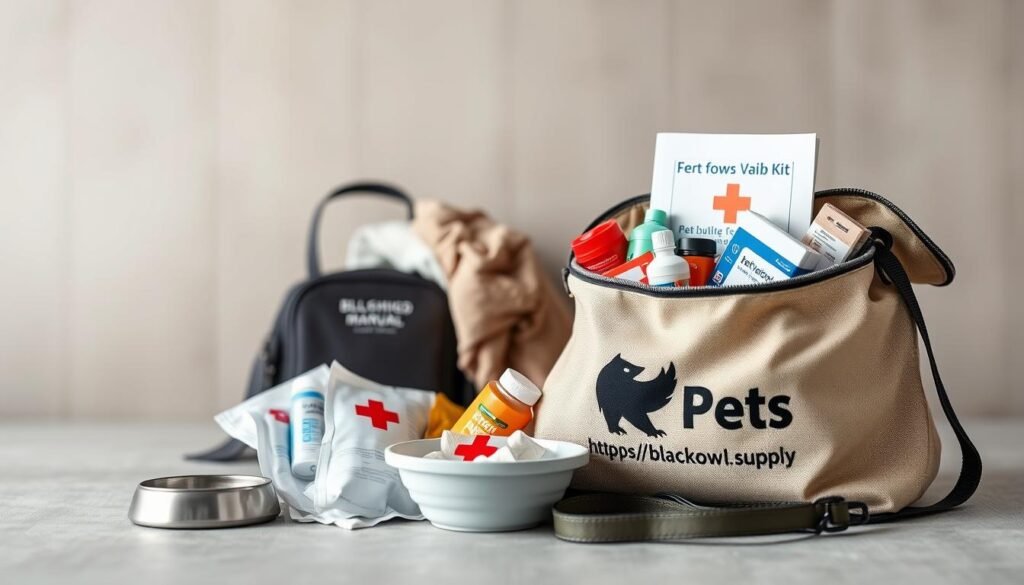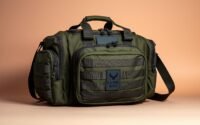Prepping for Pets: Bug-Out Plans for Your Furry Friends
Surprising fact: nearly 40% of households report they would delay evacuation because of an unplanned pet situation.
This short guide helps you take clear steps to avoid that risk. You will learn simple actions that turn vague worry into practical disaster preparedness.
Start by identifying hazards in your area—wildfire, hurricane, quake, or power outage. Then translate that information into a usable plan that keeps you and your animals safe.
As a pet owner, you will assemble records, ID, carriers, and a kit with one to two weeks of food, water, meds, and comfort items. Train basic commands and acclimate pets to carriers so evacuations go smoother.
Make sure tags and a registered microchip have current details. Keep physical copies of records since digital systems can fail. Review and rotate supplies on a regular schedule.
Key Takeaways
- Use this guide to build a pet-inclusive disaster preparedness plan.
- Identify local threats, then craft clear actions for home and evacuation.
- Assemble a waterproof file with vaccination records and recent photos.
- Keep carriers, sturdy leashes, one-to-two week food and water supplies.
- Train simple commands and pre-book pet-friendly options for travel.
Start Smart: Understand Your Local Risks and Set Your How-To Goals
Begin with a simple map of likely threats in your area and set achievable goals to protect everyone at home.
Regions face different hazards — earthquakes, wildfires, hurricanes, tornadoes — plus universal threats like house fires and power outages. Planning must match your area’s risk profile and be realistic about time and resources.
Map threats, set clear goals
Map your area risk-by-risk: prioritize the most likely natural disasters and everyday disasters so your disaster plan targets what truly matters where you live.
Make proper planning and consideration top priorities; small, regular steps reduce chaos when an event hits.
- Set measurable tasks: assemble records this week; reserve a pet‑friendly hotel before high season.
- Designate a shelter-in-place room at home — interior, window-free, with space for carriers and water bowls.
- Outline decision points and timelines so you know when to shelter versus when to evacuate.
- Inventory local resources: county alerts, nearby help, and pet-friendly stops along likely routes.
Schedule quarterly reviews and update contacts, routes, and supplies. Bookmark this guide and return often — making sure your plans evolve with changing risks will save time and stress later.
Prepping for Pets: Bug-Out Plans for Your Furry Friends
An organized records packet and a ready kit cut stress and save time when an emergency starts.
Gather critical records: print vaccination paperwork, medical notes, prescriptions, and several recent photos. Seal these in a waterproof folder and keep a duplicate in your glove box.
Identification that sticks: keep collars and updated tags on at all times and verify your microchip registration and contact details.

Build a compact emergency kit
Include medications, scissors, saline eye flush, one-inch white tape, non-adhesive gauze, vet wrap, K-Y jelly for temporary wound protection, and a towel for safe handling. Avoid human meds like ibuprofen or acetaminophen; they can be deadly to animals.
Food, water, comfort, and a safe room
Store two weeks of your pet’s regular food in sealed waterproof containers and bottled water. Rotate stock quarterly.
Pack carriers, sturdy leashes or harnesses, collapsible bowls, bedding, and a favorite toy. Choose an interior, window-free safe room with sanitation supplies if shelter-in-place is needed.
- Quick checklist: printed records, current tags, microchip verified, two weeks of food and water, and a checked emergency kit.
From Plan to Action: Evacuation, Training, and Pet First Aid Essentials
Make loading your vehicle and moving out a simple, repeatable process so you act fast when needed.
Evacuation options: map routes with backups and pre-book pet-friendly hotels. Line up friends or family who can host if hotels fill. Allocate trunk space for crates, a go-bag, and your emergency kit so loading is fast.
Transport confidence
Crate-condition pets with short, positive sessions. Keep leads, crates, and towels in the car to ease handling. Stage carriers and a ready bag near the door during high-risk seasons.
Playbooks by disaster
For hurricanes, secure lodging early and bring animals indoors. For tornadoes, shelter in a small interior room or basement with your kit reachable. For floods, move to high ground and use waterproof containers. For wildfires, act on early warnings and clear a safe zone around your home.
Training and socialization
Practice commands like come, stay, quiet, and heel in noisy settings. Timed drills help you confirm you can load carriers, water, and a bag within minutes. Update plans seasonally.
Pet first aid basics
Pack gauze, vet wrap, saline eye flush, K-Y jelly, and a towel. Use light, non-constricting bandages and K-Y jelly for temporary wound protection until veterinary care is available. Exclude human medications; many are toxic to animals.
Proper planning and consideration are two of the more important keys in survival prep.
| Situation | Immediate Action | Staged Items | Timeframe |
|---|---|---|---|
| Hurricane | Secure lodging, bring pets inside | Carriers, two-week food, bag | Lock lodging 48–72 hrs before landfall |
| Tornado | Move to interior room/basement | Emergency kit, crates, towels | Immediate on warning |
| Flood | Move to high ground early | Waterproof container, flotation aid | Leave as soon as rise is forecast |
| Wildfire | Evacuate on early alerts | Air filters, carriers, go-bag | Depart when evacuation orders issued |
Bookmark this guide and revisit it often. You’ll refine lodging lists, refresh supplies, and keep your plan ready when the call to move comes.
Conclusion
Make sure, you keep this approach simple and repeatable so your pet stays safe when seconds count.
Two-week supplies of food and bottled water, printed records in a waterproof folder, an updated microchip registration, and basic species-safe first aid are the foundation of readiness. Store carriers and a labeled bag by the door.
Practice quick drills, rotate supplies annually, and avoid human medications. If you must leave your animal behind, don’t tether—leave food, water, and a clear sign for rescuers.
Proper planning and consideration are two of the more important keys in survival prep. Bookmark this guide and check it often for updated information so your family and pets have the best chance in any disaster.
FAQ
What should be in a basic pet emergency kit?
Include two weeks of your pet’s regular food, bottled water, any medications in labeled containers, a copy of vaccination records and medical notes in a waterproof folder, a spare collar with ID tags, a sturdy leash or harness, a carrier or crate, disposable litter or sanitation supplies, basic first-aid items, and a familiar toy or blanket for comfort.
How much water does my pet need during an evacuation?
Plan on at least one ounce of water per pound of body weight per day for dogs and about half an ounce per ounce of body weight for cats. Store bottled or sealed water in rotation so supplies stay fresh for the two-week window you should aim to cover.
How do I make my home safer for pets during a shelter-in-place?
Create an interior, window-free safe room with bedding, food, water, sanitation supplies, and a carrier. Secure heavy items, unplug hazards, and keep a flashlight and phone charger accessible. Make sure microchip and tag contact details are current before a disaster hits.
What identification is essential for pets in an emergency?
Use an updated collar with a durable ID tag and register a microchip with your current phone number and address. Keep a recent photo of your pet and copies of records in a waterproof folder to help reunite you if you become separated.
Can I bring my pet to shelters or hotels during disasters?
Some hotels accept pets and many counties maintain pet-friendly evacuation resources, but policies vary. Pre-book pet-friendly hotels, arrange a network of friends or family, and locate local shelters that accept animals. Always call ahead and confirm requirements for carriers and vaccination proof.
How can I safely transport a stressed pet during an evacuation?
Acclimate your pet to carriers and car rides in advance. Use secure crates or well-fitted harnesses, bring familiar bedding and treats, and include towels to reduce sliding. Keep leashes and muzzles accessible if your pet becomes frightened.
What pet first-aid items should I include and what should I avoid?
Pack gauze, adhesive tape, antiseptic wipes, an instant cold pack, styptic powder, and a pet first-aid guide. Use K-Y jelly as a safe temporary measure for some wound care. Avoid giving human medications unless directed by a veterinarian; many human drugs are toxic to animals.
How often should I rotate my pet’s food and water supplies?
Rotate dry food every six months and canned food according to manufacturer dates. Replace bottled water every six to twelve months or sooner if seals are broken. Keep a checklist and dates in your emergency kit to track rotation.
What documentation should I keep handy for vet care during a disaster?
Keep copies of vaccination records, prescription details, recent medical notes, a list of medications with dosages, and your veterinarian’s contact information. Store digital backups on a cloud service and a USB drive in a waterproof case.
How do I prepare for disaster-specific scenarios like wildfires or floods?
Develop action plans: for wildfires, evacuate early and pack your kit; for floods, move pets to higher ground and secure carriers; for hurricanes, secure your home and arrange evacuation routes and pet-friendly lodging. Know local warning systems and have multiple exit options mapped out.
What training helps pets stay calm during emergencies?
Practice basic commands—come, stay, quiet—and desensitize pets to carriers and short confinement periods. Use positive reinforcement, short, frequent training sessions, and simulate emergency routines to build confidence.
How can I find pet-friendly resources in my area ahead of time?
Contact local animal control, the American Red Cross chapter, and your county emergency management office for lists of pet-friendly shelters and hotels. Join community social media groups and register with microchip databases that offer lost-and-found services.
What should I do if I get separated from my pet during a disaster?
File lost-pet reports with local shelters, post clear recent photos and details on social media and lost-pet websites, contact veterinary clinics, and check microchip databases. Keep your contact info updated on tags and microchips to increase chances of a quick reunion.


